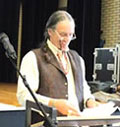Hi folks
It has been a difficult Winter for many of us. Travel has created its own set of trials and travails, especially by air. Nonetheless, we move forward as the economy continues to improve and work for coaches and consultants is increasing.
In this issue, we continue the conversation on coaching during succession planning processes, in particular, coaching the board. It is a more difficult process as it involves coaching a team of highly succession executives or prior executives in many cases. Not an easy task by any means, yet a very satisfying experience when the coach can stay grounded in the process and personally in the moment.
Also, the details of the upcoming coaching workshop are included. I am very excited as the pilot workshop last October was a great success.
Looking forward to seeing some of you in May.
Respectfully,
Herb Stevenson
Herb Stevenson, CEO/President
Cleveland Consulting Group
Board Responsibility During Succession Plan
Herb Stevenson, CEO
Cleveland Consulting Group, Inc.
22 February, 2014
The December newsletter was a review of the ten most important dimensions of CEO succession planning and implementation. This issue will expand on the first dimension—Board Responsibility.
Board Responsibility
From the moment that the board establishes a new CEO, the process for developing a successor starts over again from the beginning. Too often this is not done by the board so as to avoid treading on the toes of the new or outgoing CEO(s). This can quickly get in the way of the board establishing ownership, involvement and oversight for the succession process. At a minimum, the board must clarify the duties, responsibilities, authority, and required intercommunications between themselves, the CEO and the succession candidates as part of the fiduciary relationship and the ongoing succession planning process. Without doing so, the organization has no governing body and the board has no direction to guide them through the potentially treacherous waters ahead. The worst case scenario is that a succession plan becomes frozen by a CEO who will not leave and might require “a nudge out the door” in order to move the process forward. This often leads to a split board and/or a needless blemish on the outgoing CEO’s legacy. This can happen in both public and private organizations.
Case in Point
Microsoft is being closely watched as they search for a replacement for the retiring Steve Balmer. As reported in the Wall Street Journal (January 3, 2014), Microsoft Corp. is having trouble choosing a new chief executive because of awkward boardroom dynamics between a founder and prior CEO who believes he knows best and the present CEO who stepped down under pressure for a faster change in strategy. Microsoft hasn't said whether both Mr. Ballmer and Mr. Gates will remain directors. Nonetheless, it appears to be likely. In an interview with the Financial Times published in November, Mr. Gates said he expected to spend considerable time working with the next Microsoft CEO. People who have worked with him say that he can dominate board discussions.
(Subsequent to writing this article, Microsoft has named insider Satya Nadella as CEO. Even though he is a Microsoft insider, the issues of this paragraph are still applicable.)
Coach's Role
More executive coaches are finding that they are being brought in to support the CEO and/or the board during the succession process. This can be a severely trying as well as an exhilarating process for the coach. Succession is often “up close and personal” for the board as well as outgoing and incoming CEOs. In this article, the focus is on supporting the board to effectively engage and direct the succession process.
Board as a Team
In regards to team dynamics and applying them to boards of directors, it is helpful to review some coaching points that can be utilized during the succession process. According to Jon R. Katzenbach and Douglas K. Smith1, a team’s essential discipline comprises five characteristics that can serve as coaching insights and can be offered to the client organization:
A meaningful common purpose that the team has helped shape. Most teams are responding to an initial mandate from outside the team, but to be successful, the team must “own” this purpose and develop its own spin on it. In regards to boards, this becomes a unique situation as they often defer the succession process to the present and exiting CEO. As the coach, it is imperative to support the board in the understanding and acceptance of the succession planning process. A common misunderstanding is that the individual members of the board or committee and the CEO have a shared compelling picture of what succession planning actually is, let alone how it is to be performed. The coach will likely need to open the conversation, to collect viewpoint from the respective parties, and to create a set of pillars from which to build a shared understanding of the purpose and process.
Specific performance goals that flow from the common purpose. Compelling goals inspire and challenge a team, as well as providing it with a sense of urgency. They also have a leveling effect, requiring members to focus on the collective effort necessary rather than any differences in title or status.
With the fiduciary responsibility to ensure adequate supervision of the executive team and therefore that adequate succession plans and processes are in place, the board is uniquely able to guide and direct the succession process. Unfortunately, even though many directors are past and present executives from other companies, this seems to get lost or short-sheeted. The commitment to perform this function should come from the organization and not from existing executives.
Again, the coach should support the board or committee and the CEO to create a shared statement of purpose with specific goals.
A mix of complementary skills. These include technical or functional expertise, problem-solving and decision-making skills, as well as interpersonal skills. Successful teams have all the needed competencies at the outset and develop these as they learn what the challenge requires.
Generally, boards are functionally cross-fertilized and highly skilled. They might also be experienced in succession planning either personally or within the existing organization. However, if the director is a past or present CEO of another company, the dynamics can become more problematic if he/she applies these skills from the position of a peer as opposed to a director This is an altogether different internal experience.. Instead of providing direction, the role becomes one of providing support and succession planning requires direction.
Coaches can flinch at the wisp of undefined roles, responsibilities, authority, and communications expected by and between directors and the CEO. Providing clarity to such instances can raise the hair on the necks of fast moving directors who prefer to live without definitions. However, the clarity from these definitions is what will create the container for a successful succession plan.
A strong commitment to how the work gets done. Teams must agree on who will do what jobs, how schedules will be established and honored, and how decisions will be made and modified. On a genuine team, each member does equivalent amounts of real work. All members, the leader included, contribute in concrete ways to the team’s collective work-products.
There is no doubt that boards work hard and are committed to doing their job as directors. This can be shaded in regards to succession and is affected by whom the director clearly commits to support. If the relationship with outgoing or incoming CEO has been clearly defined and negotiated in terms of roles, responsibilities, authority, and communication, it is unlikely shading will occur. However, if these have not been formally vetted, the shading becomes evident in the CEO controlling too much of the succession process.
It is important that the coach is mindful of what is leading the board or committee away from the succession process and disclose that to them.
Mutual accountability. Trust and commitment cannot be coerced. The process of agreeing upon appropriate goals serves as the crucible in which members forge their accountability to each other—not just to the leader. As mentioned, most directors take pride in their commitment and willingness to be accountable. If the relationship with the outgoing or incoming CEO has been clearly defined and negotiated it is unlikely that there will be any issues. If it is not, the potential for a board of “good ole boys” arises.
As coach, the goal is to build trust and mutual accountability through developing strong dialogic processes that support the overall succession plan.
Building Better Boards for
Succession Planning
According to Jeff Sonnenfeld2, to build better boards, CEOs, lead directors, and board members themselves can work to build the relational dynamics that can ensure successful succession planning. These can be useful guidelines from which to provide coaching interventions to support the board’s effectiveness.
Build Trust and Candor
A climate of trust and candor requires face time and efforts to truly get to know one another. When that is not possible, a process to define and negotiate the roles, responsibilities/expectations, authority, and communications should be in place to provide a clear sense of the rules of engagement by and between directors and CEOs. For example, Sonnenfeld suggests, “if you’re CEO, share important and difficult information with directors in time for them to digest it—not the night before a meeting. If you’re a member, insist on receiving adequate information. To discourage members from creating back channels to line managers in pursuit of political agendas, give them access to company personnel and sites—then trust them not to meddle in day-to-day operations.” In my opinion, these can be more window dressing to the real issue of negotiating and defining the relationships so that there is no mistake of the rules of engagement including expectations for directors and their roles for succession planning. As a coach, it might be easy to slide by this area because of sensitive personalities. I encourage clarity for yourself as the coach in regards to your role. My focus in these situations it is to keep the board fully engaged with each other and with the succession process.
Foster Open Dissent
The ability to stay engaged regardless of the differences of opinion are what can lead to the best decisions. As coach, supporting this process through clear understanding of dialogic processes can be useful. Sonnefeld suggests that the board’s “willingness to challenge one another’s assumptions and beliefs may be the most important characteristic of great boards—indicating bonds strong enough to withstand clashing viewpoints.”
It is common for boards to disagree about succession planning and to veer away from the plan when it gets contentious and personal. For example, during the near end of a succession plan, one board in particular had loosely managed the process by allowing the departing CEO to lead. When it came time to formally commit to a date of departure, the board had one opinion and the CEO had another. It became quite messy when long term directors deferred to friendship and supported the CEO when he wouldn’t commit to specific transfer and departure dates. Overall, the board lost credibility in the eyes of the organization and incoming executive. Its ability to ensure successful succession without harm to the operating performance of the organization was diminished. As coach, it was my job to point out the role confusion and the impact of focusing on the needs of the CEO instead of the organization. The board did not budge in its split and the CEO remained with rippling effects inside the organization.
Multiple roles
Relationships often match personalities so that what creates a personal sense of satisfaction for board members is what they will gravitate toward. For example, it is common for boards to have a peacemaker, a damn-the-details big-picture person, and a ruthless cost-cutter. These individuals bring a razor sharp focus and clarity to the board. However, succession planning requires a much larger view of what is best for the organization. Requiring true dialogues, though perceived as time consuming and wasteful by some, leads to a richer and truer sense of what is not only needed but what is possible in the ever-changing business environment. During succession planning, this larger conversation can lead to a broader range of candidates as well as a deeper understanding of the need for change by the outgoing CEO. A coaching moment occurs when one can point out these roles and the impact on the succession process.
Summation
As evidenced by the increasing number of books being written on talent management and succession plans, coaches and consultants are more frequently being brought in more frequently to support the process. Coaches typically can have high impact by addressing the technical requirements of successful succession plans as well as the interpersonal dynamics that can undermine the process. This means that the coach should be both fully steeped in succession planning theory, concepts, and models, as well as the interpersonal dynamics of boards of directors and C-Suite executives. When these competencies are combined and utilized, the coach can generate highly impactful interventions that can support the succession process.
Footnotes
1 The Discipline of Teams by Jon R. Katzenbach and Douglas K. Smith. Harvard Business Review, July–August 2005
2 What Makes Great Boards Great by Jeffrey A. Sonnenfeld. Harvard Business Review, September 2002
Executive & Life Coaching:
A Journey into Advanced Skill Building
May 4-9, 2014
Punderson State Park, Cleveland Ohio
 Executive & Life Coaching: A Journey into Advanced Skill Building is a “coming- home” experience for those seeking to build upon their existing coaching skills. It is an indepth experience steeped in personal growth through self awareness and professional development through a refinement of your coaching/consulting skills. Though based in gestalt/ontological theory, the core concepts will be “use of self”, “presence” and “paradoxical theory of change” which permeate many coaching philosophies. In addition, we will include a form of peer coaching that is gaining momentum as a leader development process as well as a team development process.
Executive & Life Coaching: A Journey into Advanced Skill Building is a “coming- home” experience for those seeking to build upon their existing coaching skills. It is an indepth experience steeped in personal growth through self awareness and professional development through a refinement of your coaching/consulting skills. Though based in gestalt/ontological theory, the core concepts will be “use of self”, “presence” and “paradoxical theory of change” which permeate many coaching philosophies. In addition, we will include a form of peer coaching that is gaining momentum as a leader development process as well as a team development process.
Intensive
Executive & Life Coaching: A Journey into Advanced Skill Building is an intensive experience that requires a commitment to expand your knowledge and practice. This translates into an extensive manual of original writings from my 30 years of executive coaching and consulting. In addition, supporting articles that influenced the writings will be available to further deepen your practice knowledge. In short, reading to deepen will support your process.
Know-Do Gap
Robert Sutton coined the phrase, the “know-do gap” to explain that to fully embrace new learning it requires increasing the knowledge base (know) and then directly applying it through various practical experiences (do). As such, the workshop will be a mix of learn a little then do a little.
 Maximizing Your Experience
Maximizing Your Experience
Many coaching workshop experiences are viewed as learn a little from the teaching at the workshops and do a lot, with the emphasis on not reading in advance. Attendees are strongly encouraged to complete the readings in advance to maximize the experience by eliminating the Know-Do gap. If you decide to skip the readings until after the workshop, it will reduce your overall experience, but not be a deterrent to your learning.
Foundational Assumptions
We will be working in a field of energy. Hence the field phenomena will constantly impact every one. As we become more present, our capacity to have a refined form of “seeing” the various models will occur. Being open to new ways to perceive is an important aspect of the program.
We also will be impacting each other. Hence, we will be practicing the learn, apply, learn, do, learn, apply aspect of action learning/research. This can cause some discomfort, however its assumed that to learn, we must lean into our discomfort.
Taking Care of You
Each morning there will be the choice to do a walkabout on the beautiful land of the Punderson Park or to do your personal Yoga or to do a quiet reflective time near the lake. It is imperative that you grant yourself the time to rejuvenate while at this workshop. We encourage you to unplug from work if at all possible.
Assessments
There are several assessments that will need to be completed prior to arriving. The first is a detailed reflective process that will support your understanding of how you are coming into the workshop. If you do the Monday night optional class, it will be an absolute necessity. In addition it will be part of the Sunday night opening of the circle.
You will also be provided information for competing the MBTI Step 2, Form Q, the Thomas Kilmann Conflict Instrument, and the FIRO-Business. These are important as you will use class time to build your individual development plan to be implemented when you return to your practice.
The individual development plan is a reflective tool to increase your application and learning from the workshop. You are encouraged to work on it in the open evenings
 Professional Requirements
Professional Requirements
Participants will be supported by having completed a Gestalt or ontologically based coaching/consulting or therapy certification program or one or more intensive Gestalt or Ontological OD experience(s) that consisted of at least 15 classroom days in length prior to coming to this workshop. Basic gestalt concepts will not be reviewed in this intensive program. If you are unsure, please contact us for clarification or complete the application from which a decision will be made.
Limited Size
To maximize your experience, the class is limited to 16 advanced participants.

Facilities
 The workshop will be at the Punderson State Park near Cleveland in Newbury, OH 44065. It is located on rolling hills overlooking the Punderson Lake with many hiking trails. There is a wonderful restaurant and bar for dining and after-hours enjoyment.
The workshop will be at the Punderson State Park near Cleveland in Newbury, OH 44065. It is located on rolling hills overlooking the Punderson Lake with many hiking trails. There is a wonderful restaurant and bar for dining and after-hours enjoyment.
Room Reservations
Rooms have been reserved for this workshop. Please indicate “Coaching Workshop” to get the reduced rate per night for in the Manor. The room rates includes breakfast and lunch for every day. For those wanting time with friends, there are cabins for 2-4 people. Contact Punderson directly at (440) 564-9144.
Transportation
It is approximately a one-hour trip to Punderson from either the Cleveland Hopkins or the Akron/Canton airports. Rental cars are available at the airports or there is an excellent Limo service. Contact SHIMA LIMOUSINE SERVICE, INC., 7555 Tyler Blvd #12, Mentor OH 44060. Phone: 440-918-6400, Email: info@shimalimo.com. I suggest coordinating and sharing rides.
Fees
The fee for Executive & Life Coaching: A Journey into Advanced Skill Building including all materials is $2900.00. There is a $400 discount if paid in full by March 1, 2014. Make checks payable and mail with your application to Cleveland Consulting Group, Inc., 9796 Cedar Road, Novelty, Ohio 44072-9747.
Presenter
Herb Stevenson will facilitate the workshop.
Drinking from the Talent Well
Due to the highly talented nature of the participants, we will draw upon each other to deepen the learning.
Course Topics
Pertinent pre-reading can be done by using the link to the website.
Register Now
To keep the world from closing in on you,
do one thing every day that is uncomfortable,
dislike-able or unnerving.
“One must still have chaos in oneself
to be able to give birth
to a dancing star”
—Nietzsche
Anxiety tests our courage to stand alone,
our courage to be part of a larger whole
such as a family or community or organization,
and the courage to be responsible
to the whole of creation,
including all that is of or on the earth.


 Executive & Life Coaching: A Journey into Advanced Skill Building is a “coming- home” experience for those seeking to build upon their existing coaching skills. It is an indepth experience steeped in personal growth through self awareness and professional development through a refinement of your coaching/consulting skills. Though based in gestalt/ontological theory, the core concepts will be “use of self”, “presence” and “paradoxical theory of change” which permeate many coaching philosophies. In addition, we will include a form of peer coaching that is gaining momentum as a leader development process as well as a team development process.
Executive & Life Coaching: A Journey into Advanced Skill Building is a “coming- home” experience for those seeking to build upon their existing coaching skills. It is an indepth experience steeped in personal growth through self awareness and professional development through a refinement of your coaching/consulting skills. Though based in gestalt/ontological theory, the core concepts will be “use of self”, “presence” and “paradoxical theory of change” which permeate many coaching philosophies. In addition, we will include a form of peer coaching that is gaining momentum as a leader development process as well as a team development process.  Maximizing Your Experience
Maximizing Your Experience Professional Requirements
Professional Requirements
 The workshop will be at the
The workshop will be at the